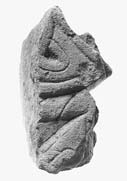Select a site alphabetically from the choices shown in the box below. Alternatively, browse sculptural examples using the Forward/Back buttons.
Chapters for this volume, along with copies of original in-text images, are available here.
Object type: Fragment of cross-head and -shaft [1]
Measurements: H. 22.5 cm (8.75 in) W. 14 cm (5.5 in) D. 16 > 14.5 cm (6.25 > 5.75 in)
Stone type: Pale grey oolitic limestone grainstone composed of closely-packed ooliths of around 0.3mm diameter (range 0.2 to 0.4mm); no shell fragments. Ancaster Freestone, Upper Lincolnshire Limestone, Inferior Oolite Group
Plate numbers in printed volume: Ills. 235–7
Corpus volume reference: Vol 5 p. 198-199
(There may be more views or larger images available for this item. Click on the thumbnail image to view.)
Broken fragment from a free-standing cross, cross-head type E8, with ring a. Despite its small size it has pierced interstices and neatly executed decoration in low relief. The ring is undecorated and of rectangular section, 3.5 cm (1.5 in) by 10.5 cm (4.25 in).
A and C (broad): The surviving cross-arm is decorated on both broad faces with the remains of simple pattern E interlace with medial incised strands. This is contained within a plain border of square section and was probably repeated in each arm. Sufficient survives of the shaft to show that it was of rectangular section with cabling on roll-moulded arrises, that was turned to form a border along the top of each face. The panels on both broad faces were filled with interlace also with a medial incised line. It may have formed a variation of simple pattern E, as reconstructed by Stocker on the basis of similar shafts at Colsterworth (no. 1, Ill. 94) and Little Shelford, Cambridgeshire (Stocker 1986a, fig. 50).
B (narrow): On the one surviving narrow face, all decoration has gone except for a single boss or pellet and a mutilated cable moulding.
The small size of this piece suggests that it functioned as a grave-marker rather than as a major standing cross. In this respect its parallels lie in the group of examples from Cambridge Castle, Fulbourn and Stapleford, Cambridgeshire, and Whissonsett, Norfolk, discussed by Fox (1920–1, 15–17). Its precise analogy in size and decoration, however, is the cross-head from Colsterworth (no. 2, Ills. 92–3). What exists of an interlace pattern on the broad faces of St Mark 1 corresponds to that found on both faces of the Colsterworth head, which therefore probably indicates the full decorative scheme at Lincoln St Mark: one broad face of the Colsterworth shaft (no. 1, Ills. 94–8) carries a double Stafford knot motif (simple pattern E) that can also be reconstructed on this Lincoln example (Stocker 1986a, fig. 50). The narrow faces at Colsterworth deploy a simple three-strand plait rather than a design employing bosses or pellets; bosses do, however, form part of the decorative repertoire on the cross-head from Conisholme (Ill. 100). What further associates the two Lincolnshire pieces and distinguishes them from the East Anglian group is the way that in the latter cases the decoration on the cross-head is not marked off from that on the shaft as it is at Lincoln St Mark 1 and Colsterworth. Fox dates the East Anglian group to the late tenth or early eleventh century (1920–1, 35–41). This would suit a context within the early phases of the St Mark's cemetery. The close similarity of this piece with that at Colsterworth suggests their origin in the same workshop.



